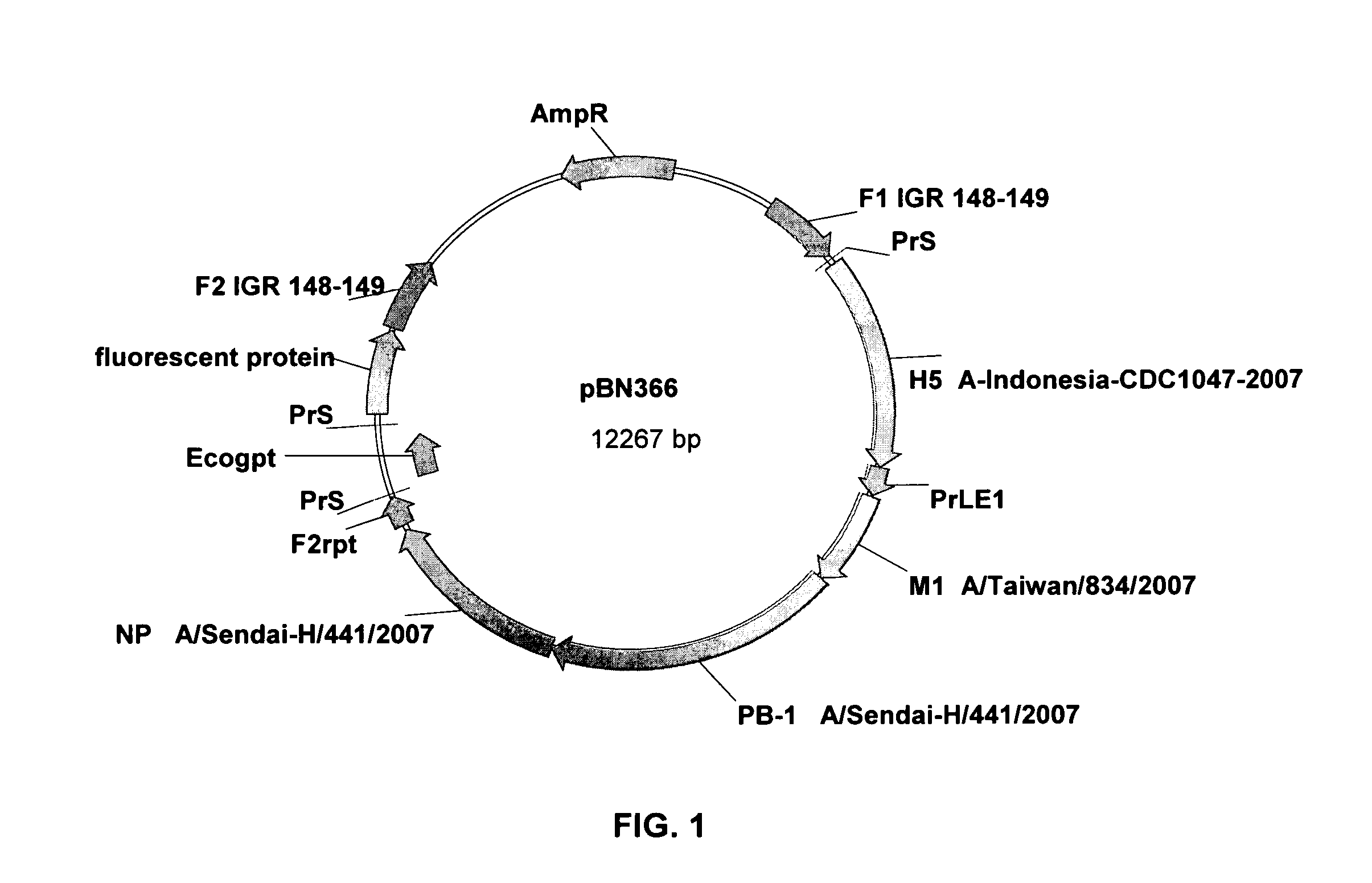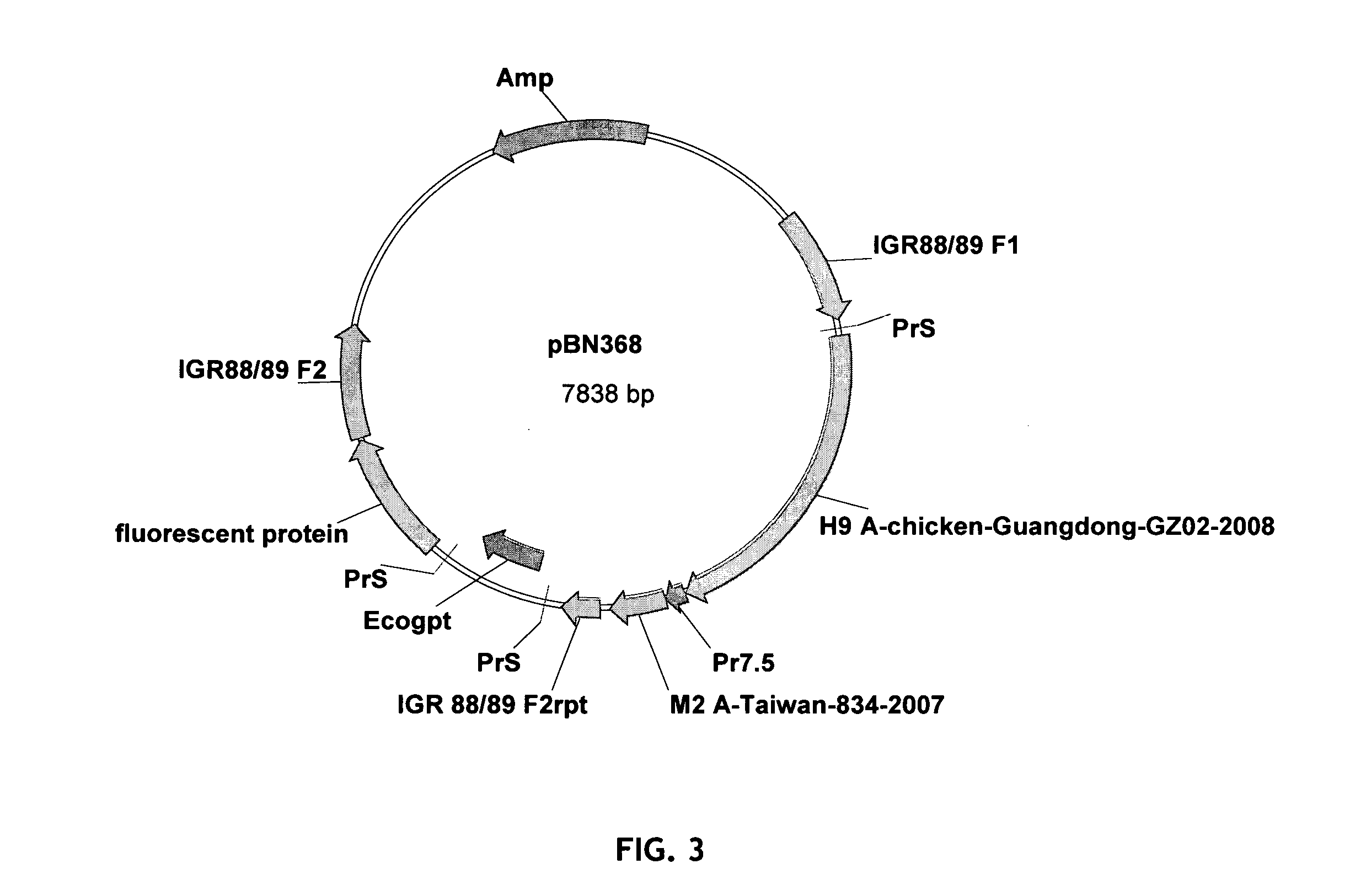Recombinant modified vaccinia virus ankara influenza vaccine
a technology of vaccinia virus and recombinant modified vaccinia, which is applied in the direction of dsdna viruses, antibody medical ingredients, immunological disorders, etc., can solve the problems of poor immunogenicity in elderly people, antibody response may not be effective against novel virus strains, and counterproductive to immune constitution, etc., to achieve effective inducing effect and safety established
- Summary
- Abstract
- Description
- Claims
- Application Information
AI Technical Summary
Benefits of technology
Problems solved by technology
Method used
Image
Examples
example 1
Generation of MVA-PanFlu
[0176]The MVA-PanFlu construct is based on MVA-BN and was generated by 4 consecutive insertions of the foreign genes via homologous recombination. The selection genes were removed by additional recombination reactions. The resulting virus stocks (Premaster) have been extensively tested for virus identity, absence of wild-type or precursor virus, absence of selection genes, correct insertion of the inserts, and transcription of the inserts by RT-PCR. The sequences of all inserts and surrounding MVA-sequences have been verified.
example 2
Generation of MVA-mBN208A
[0177]To generate a recombinant MVA based on the strain MVA-BN, a recombination plasmid for integration of foreign genes into the IGR 64 / 65 (intergenic region between genes 64 and 65 of MVA-BN, as described in WO 03 / 097845) was engineered to contain the neuraminidase gene and the H2 gene each under control of a promoter for poxyiral expression. This recombination plasmid pBN367 (FIG. 2.) was used for homologous recombination in CEF cells with MVA-BN. The resulting recombinant virus MVA-mBN208A was plaque purified twice and used as the basis to integrate the next insertion. The selection cassette was deleted during generation of MVA-mBN209B. Generally, “A” as the last letter of a virus name designates a recombinant virus still containing a selection cassette whereas “B” as last letter in a virus name designates viruses where the selection cassette has been deleted.
example 3
Generation of MVA-mBN209B
[0178]To generate the recombinant MVA-mBN209B, (based on MVA-mBN208A), a recombination plasmid for integration of foreign genes into the IGR 88 / 89 (intergenic region between genes 88 and 89 of MVA-BN, as described in WO 03 / 097845) was engineered to have the H9 gene and the M2 gene each under control of a promoter for poxyiral expression. This recombination plasmid pBN368 (FIG. 3.) was used for homologous recombination in CEF cells with MVA-mBN208A. The resulting recombinant virus MVA-mBN209B was plaque purified five times after the loss of the selection genes and used as the basis to integrate the next insertion. The production of a Premaster of MVA-mBN209 with an adequate viral titer (which means at least 1×107 viral particles / ml) needed several rounds of additional amplification before the final Premaster with a viral titer of 4.6×107 / ml could be generated.
PUM
| Property | Measurement | Unit |
|---|---|---|
| Molar density | aaaaa | aaaaa |
Abstract
Description
Claims
Application Information
 Login to View More
Login to View More - R&D
- Intellectual Property
- Life Sciences
- Materials
- Tech Scout
- Unparalleled Data Quality
- Higher Quality Content
- 60% Fewer Hallucinations
Browse by: Latest US Patents, China's latest patents, Technical Efficacy Thesaurus, Application Domain, Technology Topic, Popular Technical Reports.
© 2025 PatSnap. All rights reserved.Legal|Privacy policy|Modern Slavery Act Transparency Statement|Sitemap|About US| Contact US: help@patsnap.com



